Studies on the Efficiency of Iron Release from Fe(III)-EDTA and Fe(III)-Cit and the Suitability of These Compounds for Tetracycline Degradation
Abstract
:1. Introduction
2. Results and Discussion
2.1. Absorption Spectra
2.2. Fluorescence Spectra
2.3. Quantum Chemistry Calculations
3. Materials and Methods
Quantum Chemistry Calculations
4. Conclusions
Supplementary Materials
Author Contributions
Funding
Institutional Review Board Statement
Informed Consent Statement
Data Availability Statement
Conflicts of Interest
Sample Availability
References
- Polianciuc, S.I.; Gurzău, A.E.; Kiss, B.; Ştefan, M.G.; Loghin, F. Antibiotics in the environment: Causes and consequences. Med. Pharm. Rep. 2020, 93, 231–240. [Google Scholar] [CrossRef] [PubMed]
- Cizmas, L.; Sharma, V.K.; Gray, C.M.; McDonald, T.J. Pharmaceuticals and personal care products in waters: Occurrence, toxicity, and risk. Environ. Chem. Lett. 2015, 13, 381–394. [Google Scholar] [CrossRef] [PubMed] [Green Version]
- Daghrir, R.; Drogui, P. Tetracycline antibiotics in the environment: A review. Environ. Chem. Lett. 2013, 11, 209–227. [Google Scholar] [CrossRef]
- Zhang, M.; He, L.Y.; Liu, Y.S.; Zhao, J.L.; Liu, W.R.; Zhang, J.N.; Chen, J.; He, L.K.; Zhang, Q.Q.; Ying, G.G. Fate of veterinary antibiotics during animal manure composting. Sci. Total Environ. 2019, 650 Pt 1, 1363–1370. [Google Scholar] [CrossRef]
- Chen, R.; Yan, Z.Q.; Feng, D.; Luo, Y.P.; Wang, L.L.; Shen, D.X. Nosocomial blood stream infection in patients caused by Staphylococcus aureus: Drug susceptibility, outcome, and risk factors for hospital mortality China. Med. J. Eng. 2012, 125, 226–229. [Google Scholar]
- Gelband, H.; Miller, M.P.; Pant, S.; Gandra, S.; Levinson, J.; Barter, D.; White, A.; Laxminarayan, R. Wound Healing Southern Africa—The state of the world’s antibiotics 2015. In Wound Heal. South. Africa. Center for Disease Dynamics, Economics & Policy; CDDEP: Washington, DC, USA, 2015; Available online: https://onehealthtrust.org/publications/reports/state-of-worlds-antibiotics-2015-2/ (accessed on 29 November 2022).
- Van Boeckel, T.P.; Brower, C.; Gilbert, M.; Grenfell, B.T.; Levin, S.A.; Robinson, T.P.; Teillant, A.; Laxminarayan, R. Global trends in antimicrobial use in food animals. Proc. Natl. Acad. Sci. USA 2015, 112, 5649–5654. [Google Scholar] [CrossRef] [Green Version]
- EMA. European Medicines Agency Sales of Veterinary Antimicrobial Agents in 30 European Countries in 2016-Trends from 2010 to 2016—Eight ESVAC Report. 2018. Available online: https://www.ema.europa.eu/en/documents/report/sales-veterinary-antimicrobial-agents-30-european-countries-2016-trends-2010-2016-eighth-esvac_en.pdf (accessed on 5 December 2021).
- Miao, X.S.; Bishay, F.; Chen, M.; Metcalfe, C.D. Occurrence of antimicrobials in the final effluents of wastewater treatment plants in Canada. Environ. Sci. Technol. 2004, 38, 3533–3541. [Google Scholar] [CrossRef]
- Schwertmann, U.; Fitzpatrick, R.W. Iron minerals in surface environments. Catena Supp. 1992, 21, 7–30. [Google Scholar]
- Cornell, R.M.; Schwertmann, U. The Iron Oxides, Structure, Properties, Reactions, Occurrence and Uses; VCH: Weinheim, Germany, 1996. [Google Scholar]
- Thamdrup, B. Bacterial manganese and iron reduction in aquatic sediments. Adv. Microb. Ecol. 2000, 16, 41–84. [Google Scholar]
- Chander, Y.; Kumar, K.; Goyal, S.M.; Gupta, S.C. Antibacterial activity of soil-bound antibiotics. J. Environ. Qual. 2005, 34, 1952–1957. [Google Scholar] [CrossRef]
- Walters, E.; McClellan, K.; Halden, R.U. Occurrence and loss over three years of 72 pharmaceuticals and personal care products from biosolids-soil mixtures in outdoor mesocosms. Water Res. 2010, 44, 6011–6020. [Google Scholar] [CrossRef] [PubMed] [Green Version]
- Zhao, L.; Dong, Y.H.; Wang, H. Residues of veterinary antibiotics in manures from feedlot livestock in eight provinces of China. Sci. Total Environ. 2010, 408, 1069–1075. [Google Scholar] [CrossRef] [PubMed]
- Wei, R.; Ge, F.; Huang, S.; Chen, M.; Wang, R. Occurrence of veterinary antibiotics in animal wastewater and surface water around farms in Jiangsu Province, China. Chemosphere 2011, 82, 1408–1414. [Google Scholar] [CrossRef] [PubMed]
- Ziółkowska, A.; Margas, M.; Grajek, H.; Wasilewski, J.; Adomas, B.; Michalczyk, D.; Piotrowicz-Cieślak, A.I. Comparison of UV-C irradiation, ozonation, and iron chelates treatments for degradation of tetracycline in water. Int. J. Environ. Sci. Technol. 2016, 13, 1335–1346. [Google Scholar] [CrossRef] [Green Version]
- Figueroa, R.A.; Leonard, A.; Mackay, A.A. Modeling tetracycline antibiotic sorption to clays. Environ. Sci. Technol. 2004, 38, 476–483. [Google Scholar] [CrossRef]
- Kulshrestha, P.; Giese, R.F., Jr.; Aga, D.S. Investigating the molecular interactions ofoxytetracycline in clay and organic matter: Insights on factors affecting its mobilityin soil. Environ. Sci. Technol. 2004, 38, 4097–4105. [Google Scholar] [CrossRef]
- Xu, Z.Y.; Fan, J.; Zheng, S.R.; Ma, F.F.; Yin, D.Q. On the adsorption of tetracycline by calcined magnesium-aluminum hydrotalcites. J. Environ. Qual. 2009, 38, 1302–1310. [Google Scholar] [CrossRef]
- Gu, C.; Karthikeyan, K.G. Interaction of tetracycline with aluminum and iron hydrous oxides. Environ. Sci. Technol. 2005, 39, 2660–2667. [Google Scholar] [CrossRef]
- Figueroa, R.A.; Mackay, A.A. Sorption of oxytetracycline to iron oxides and iron oxide-rich soils. Environ. Sci. Technol. 2005, 39, 6664–6671. [Google Scholar] [CrossRef]
- Liu, H.; Yang, Y.; Kang, J.; Fan, M.; Qu, J. Removal of tetracycline from water by Fe-Mn binary oxide. J. Environ. Sci. 2012, 24, 242–247. [Google Scholar] [CrossRef]
- Pulicharla, R.; Hegde, K.; Brar, S.K.; Surampalli, R.Y. Tetracyclines metal complexation: Significance and fate of mutual existence in the environment. Environ. Pollut. 2017; 221, 1–14. [Google Scholar] [CrossRef]
- Wang, L.; Yan, B.X.; Pan, X.F.; Zhu, H. The spatial variation and factors controlling the concentration of total dissolved iron in rivers, Sanjiang Plain. CLEAN Soil Air Water 2012, 40, 712–717. [Google Scholar] [CrossRef]
- Chen, Y.; Hu, C.; Qu, J.; Yang, M. Photodegradation of tetracycline and formation of reactive oxygen species in aqueous tetracycline solution under simulated sunlight irradiation. J. Photochem. Photobiol. A Chem. 2008, 197, 81–87. [Google Scholar] [CrossRef]
- Chelate Fertilizers. Available online: http://www.gs.czempin.pl/asp/pliki/nawozy_krajowe/adobe_chelaty.pdf (accessed on 29 November 2022).
- Versatile Metal Ion Chelates. Available online: https://www.dow.com/en-us/product-technology/pt-amines/pg-amines-chelants.html (accessed on 29 November 2022).
- Papastylianou, I. Effectiveness of iron chelates and FeSO4 for correcting iron chlorosis of peanut on calcareous soils. J. Plant Nutr. 1990, 13, 555–566. [Google Scholar] [CrossRef]
- Agricultural Chelates Market. Available online: https://www.marketsandmarkets.com/Market-Reports/agricultural-chelates-market-187423817.html (accessed on 29 November 2022).
- Fernandeza, V.; Winkelmannband, G.; Ebert, G. Iron supply to tobacco plants trough foliar application of iron citrate and ferric dimerum acid. Physiol. Plant. 2004, 122, 380–385. [Google Scholar] [CrossRef]
- Strobel, B.W. Influence of vegetation on low-molecular-weight carboxylic acids in soil solution—A review. Geoderma 2001, 99, 169–198. [Google Scholar] [CrossRef]
- Baziramakenga, R.; Simard, R.R.; Leroux, G.D. Determination of organic acids in soil extracts by ion chromatography. Soil Biol. Biochem. 1995, 27, 349–356. [Google Scholar] [CrossRef]
- Block, G.A. Ferric citrate in patients with chronic kidney disease. Semin. Nephrol. 2016, 36, 130–135. [Google Scholar] [CrossRef] [PubMed]
- Chertow, G.M.; Block, G.A.; Neylan, J.F.; Pergola, P.E.; Uhlig, K.; Fishbane, S. Safety and efficacy of ferric citrate in patients with nondialysis-dependent chronic kidney disease. PLoS ONE 2017, 12, e0188712. [Google Scholar] [CrossRef] [PubMed] [Green Version]
- Smyk, B.; Piotrowicz-Cieślak, A.I.; Grajek, H.; Rydzyński, D.; Margas, M.; Wasilewski, J. Influence of light and Fe(III) ions on tetracycline degradation. Spectrochim. Acta A Mol. Biomol. Spectrosc. 2019, 216, 273–282. [Google Scholar] [CrossRef] [PubMed]
- Rydzyński, D.; Piotrowicz-Cieślak, A.I.; Grajek, H.; Wasilewski, J. Investigation of chlorophyll degradation by tetracycline. Chemosphere 2019, 229, 409–417. [Google Scholar] [CrossRef] [PubMed]
- Zhou, Y.; Niu, L.; Zhu, S.; Lu, H.; Liu, W. Occurrence, abundance, and distribution of sulfonamide and tetracycline resistance genes in agricultural soils across China. Sci. Total Environ. 2017, 599–600, 1977–1983. [Google Scholar] [CrossRef] [PubMed]
- Guha Roy, A. Antibiotics in water. Nat. Sustain. 2019, 2, 356. [Google Scholar] [CrossRef]
- Rydzyński, D.; Piotrowicz-Cieślak, A.I.; Grajek, H.; Michalczyk, D.J. Chlorophyll degradation by tetracycline and cadmium in spinach (Spinacia oleracea L.) leaves. Int. J. Environ. Sci. Technol. 2019, 16, 6301–6314. [Google Scholar] [CrossRef] [Green Version]
- Krupka, M.; Piotrowicz-Cieślak, A.I.; Michalczyk, D.J. Effects of antibiotics on the photosynthetic apparatus of plants. J. Plant Interact. 2022, 17, 96–104. [Google Scholar] [CrossRef]
- Adomas, B.; Antczak-Marecka, J.; Nalecz-Jawecki, G.; Piotrowicz-Cieślak, A.I. Phytotoxicity of enrofloxacin soil pollutant to narrow-leaved lupin plant. Pol. J. Environ. Stud. 2013, 22, 71–76. [Google Scholar]
- Shinoda, K.; Matsubara, E.; Muramatsu, A.; Waseda, Y. Local structure of ferric hydroxide Fe(OH)3 in aqueous solution by the anomalous X-ray scattering and EXAFS methods. Mater. Tran. JIM 1994, 35, 394–398. [Google Scholar] [CrossRef] [Green Version]
- Wang, H.; Yao, H.; Sun, P.; Pei, J.; Li, D.; Huang, C.H. Oxidation of tetracycline antibiotics induced by Fe (III) ions without light irradiation. Chemosphere 2015, 119, 1255–1261. [Google Scholar] [CrossRef]
- Petrenko, M.; Titov, V.; Vladimirov, A. Metabolites of tetracycline obtained during its irradiation with visible light or peroxidase oxidation. Their toxic properties in relation to hemoglobin. Antibiot. Khimioter. 1995, 40, 8–14. [Google Scholar]
- Wincklerm, C.; Grafe, A. Abschätzung des Stoffeintrags in Böden durch Tierarzneimittel und pharmakolo-gisch wirksame Futterzusatzstoffe unter besonderer Berücksichtigung der Tetracycline. Herausgeber Umweltbundesamt Forsch. 2000, 297, 911. [Google Scholar]
- Saghi, M.; Mahanpoor, K. Photocatalytic degradation of tetracycline aqueous solutions by nanospherical α-Fe2O3 supported on 12-tungstosilicic acid as catalyst: Using full factorial experimental design. Int. J. Ind. Chem. 2017, 8, 297–313. [Google Scholar] [CrossRef] [Green Version]
- Yao, H.; Pei, J.; Wang, H.; Fu, J. Effect of Fe(II/III) on tetracycline degradation under UV/VUV irradiation. Chem. Eng. J. 2017, 308, 193–201. [Google Scholar] [CrossRef]
- Foster, R. Organic Charge-Transfer Complexes; Academic Press: London, UK; New York, NY, USA, 1969. [Google Scholar]
- Schmitt, M.O.; Schneider, S. Spectroscopic investigation of complexation between various tetracyclines and Mg2+ or Ca2+. Phys. Chem. Comm. 2000, 3, 42–55. [Google Scholar] [CrossRef]
- Schneider, S.; Schmitt, M.O.; Brehm, G.; Reiher, M.; Matousek, P.; Towrie, M. Fluorescence kinetics of aqueous solutions of tetracycline and its complexes with Mg2+ and Ca2+. Photochem. Photobiol. Sci. 2003, 2, 1107–1117. [Google Scholar] [CrossRef]
- Schneider, S. Proton and metal ion binding of tetracyclines. In Tetracyclines in Biology, Chemistry and Medicine; Nelson, M., Hillen, W., Greenwald, R.A., Eds.; Springer: Basel, Switzerland, 2001; pp. 65–104. [Google Scholar]
- Wessels, J.M.; Ford, W.E.; Szymczak, W.; Schneider, S. The complexation of tetracycline and anhydrotetracycline with Mg2+ and Ca2+: A spectroscopic study. J. Phys. Chem. B 1998, 102, 9323–9331. [Google Scholar] [CrossRef]
- Jeong, J.; Song, W.; Cooper, W.J.; Jung, J.; Greaves, J. Degradation of tetracycline antibiotics: Mechanisms and kinetic studies for advanced oxidation/reduction processes. Chemosphere 2010, 78, 533–540. [Google Scholar] [CrossRef] [PubMed]
- Resource Book for Sixth-Form Practical Chemistry, 2015. Synthesis of an Iron(III)-EDTA Complex. Co-Produced by the Chinese University of Hong Kong, Education and Manpower Bureau and Hong Kong Examinations and Assessment Authority. Available online: http://www.cuhk.edu.hk/chem/en/resources/f6resoursebk-eimg06.html (accessed on 5 December 2021).
- Kasparek, A.; Smyk, B. A new approach to the old problem: Inner filter effect type I and II in fluorescence. Spectrochim. Acta A Mol. Biomol. Spectrosc. 2018, 198, 297–303. [Google Scholar] [CrossRef] [PubMed]
- Latscha, H.P.; Klein, H.A. Analytische Chemie: Chemie—Basiswissen III; Springer-Verlag: New York, NY, USA, 2013. [Google Scholar]
- Martell, A.E.; Smith, R.M. Carboxylic acids. In Other Organic Ligands; Springer: Boston, MA, USA, 1977; pp. 1–171. [Google Scholar]
- Silva, A.M.; Kong, X.; Parkin, M.C.; Cammack, R.; Hider, R.C. Iron (III) citrate speciation in aqueous solution. Dalton Trans. 2009, 40, 8616–8625. [Google Scholar] [CrossRef]
- Becke, A.D. Density-Functional Thermochemistry: The Role of Exact Exchange. J. Chem. Phys. 1993, 98, 5648–5652. [Google Scholar] [CrossRef] [Green Version]
- Andrae, D.; Haußermann, H.; Dolg, M.; Stoll, H.; Preuß, H. Energy-adjusted ab initio pseudopotentials for the second and third row transition elements. Theor. Chim. Acta 1990, 77, 123–141. [Google Scholar] [CrossRef]
- Miertuš, S.; Scrocco, E.; Tomasi, J. Electrostatic interaction of a solute with a continuum. A direct utilization of AB initio molecular potentials for the prevision of solvent effects. Chem. Phys. 1981, 55, 117–129. [Google Scholar] [CrossRef]
- Miertus, S.; Tomasi, J. Approximate evaluations of the electrostatic free energy and internal energy changes in solution processes. Chem. Phys. 1982, 65, 239–245. [Google Scholar] [CrossRef]
- Becke, A.D. Density-Functional Thermochemistry: The Role of Exact Exchange. J. Chem. Phys. 1993, 98, 1372–1377. [Google Scholar] [CrossRef]
- Rappé, A.K.; Casewit, C.J.; Colwell, K.S.; Goddard, W.A., III; Skiff, W.M. UFF, a full periodic table force field for molecular mechanics and molecular dynamics simulations. J. Am. Chem. Soc. 1992, 114, 10024–10035. [Google Scholar] [CrossRef]
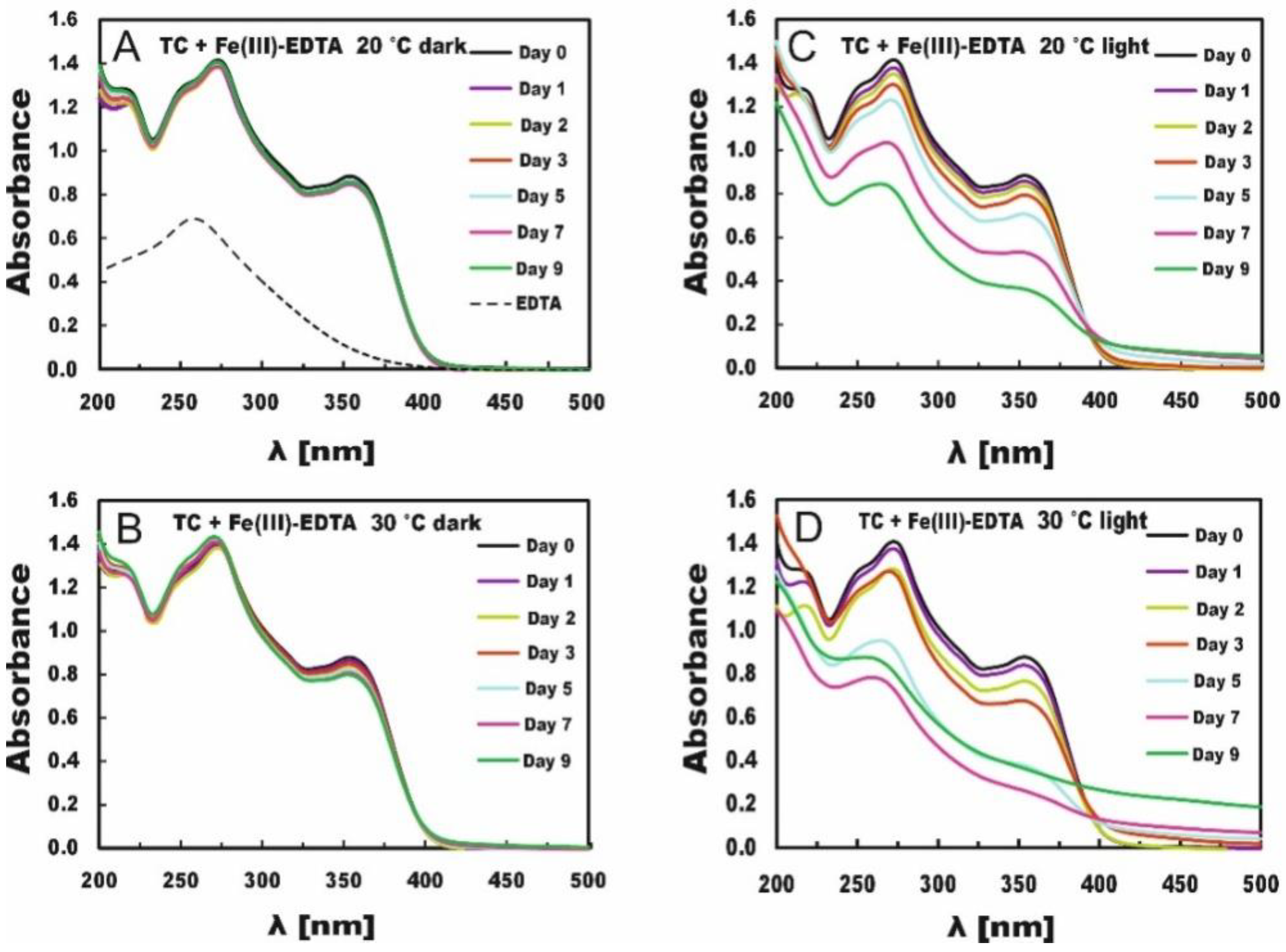



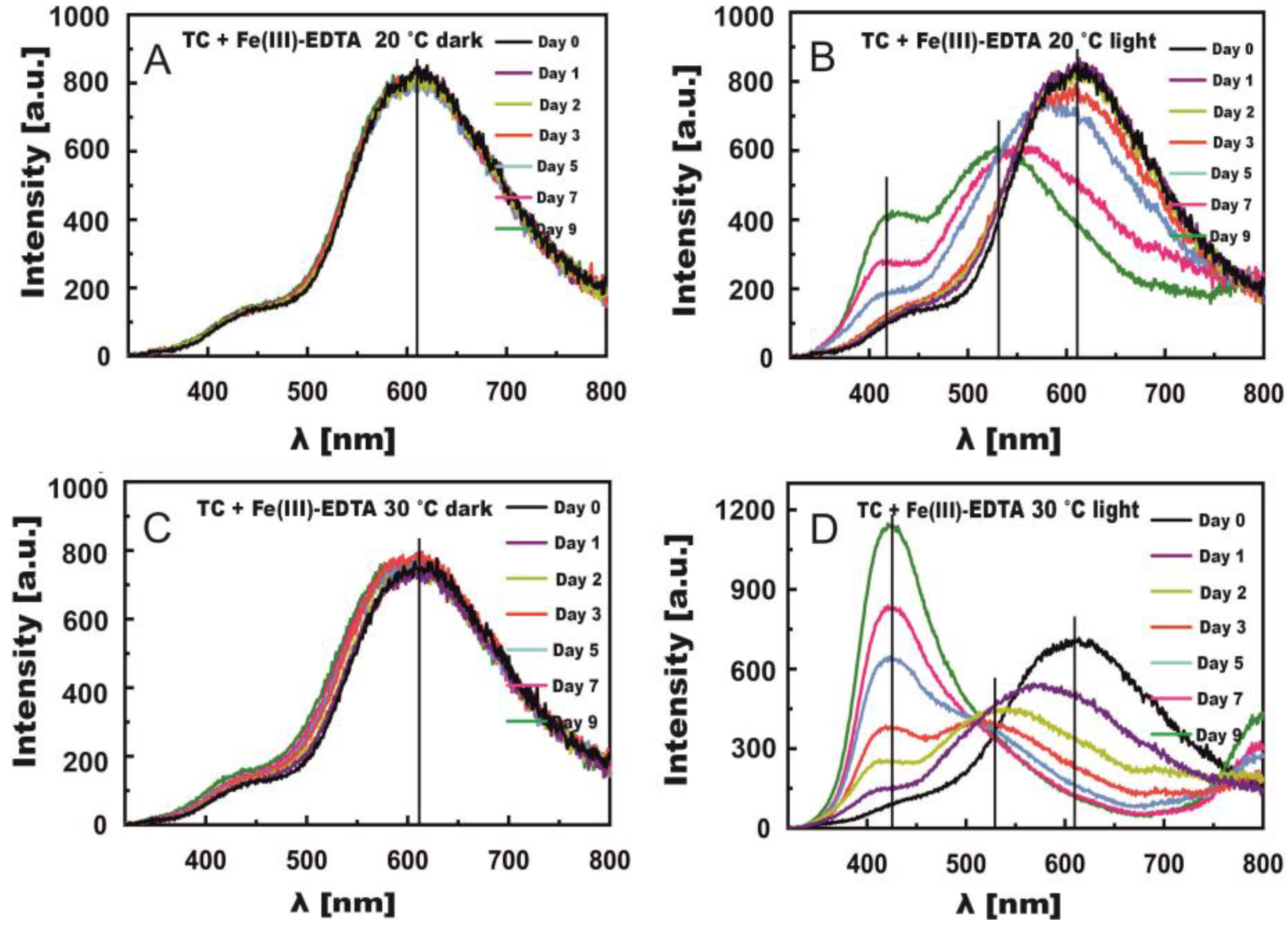



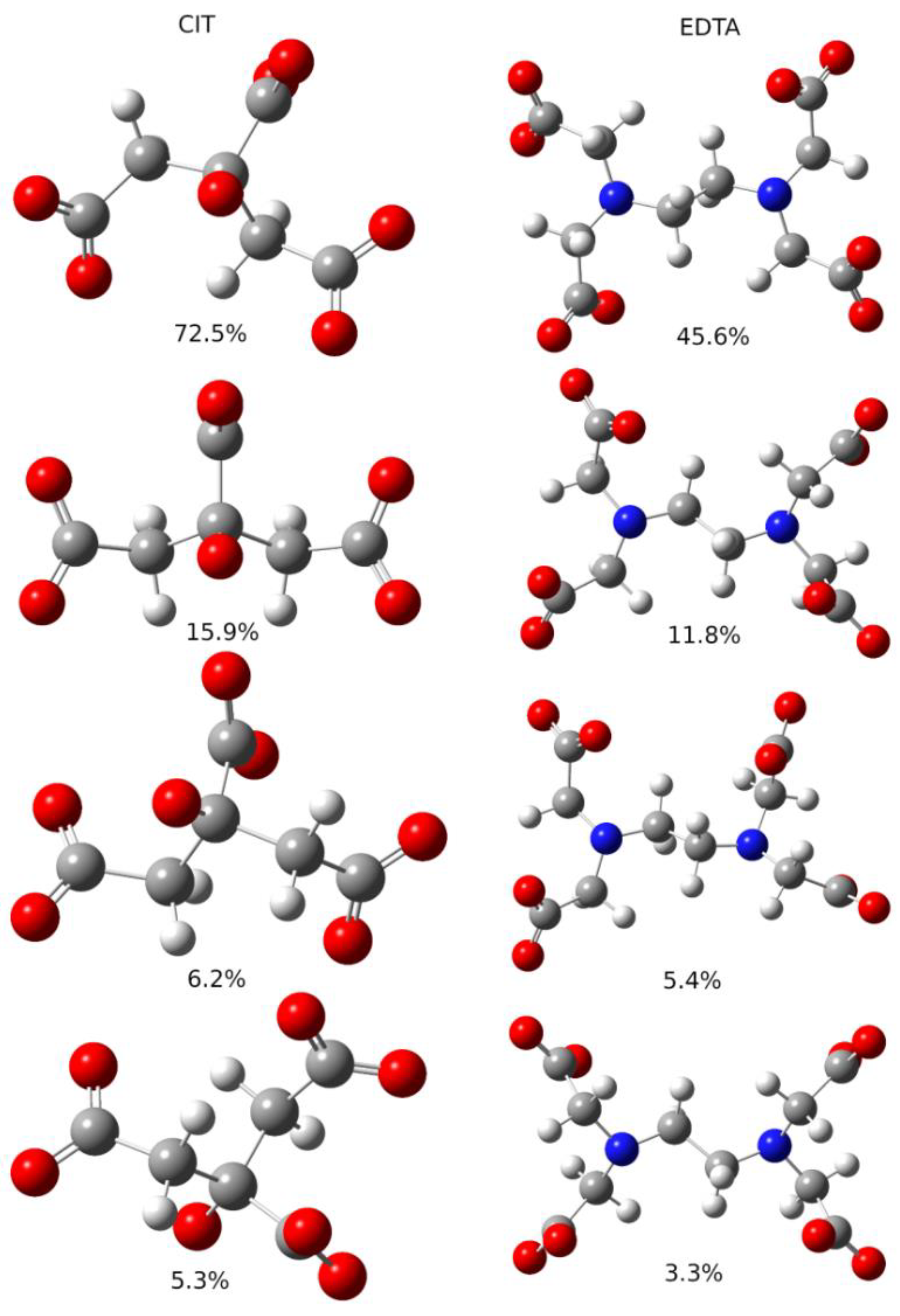
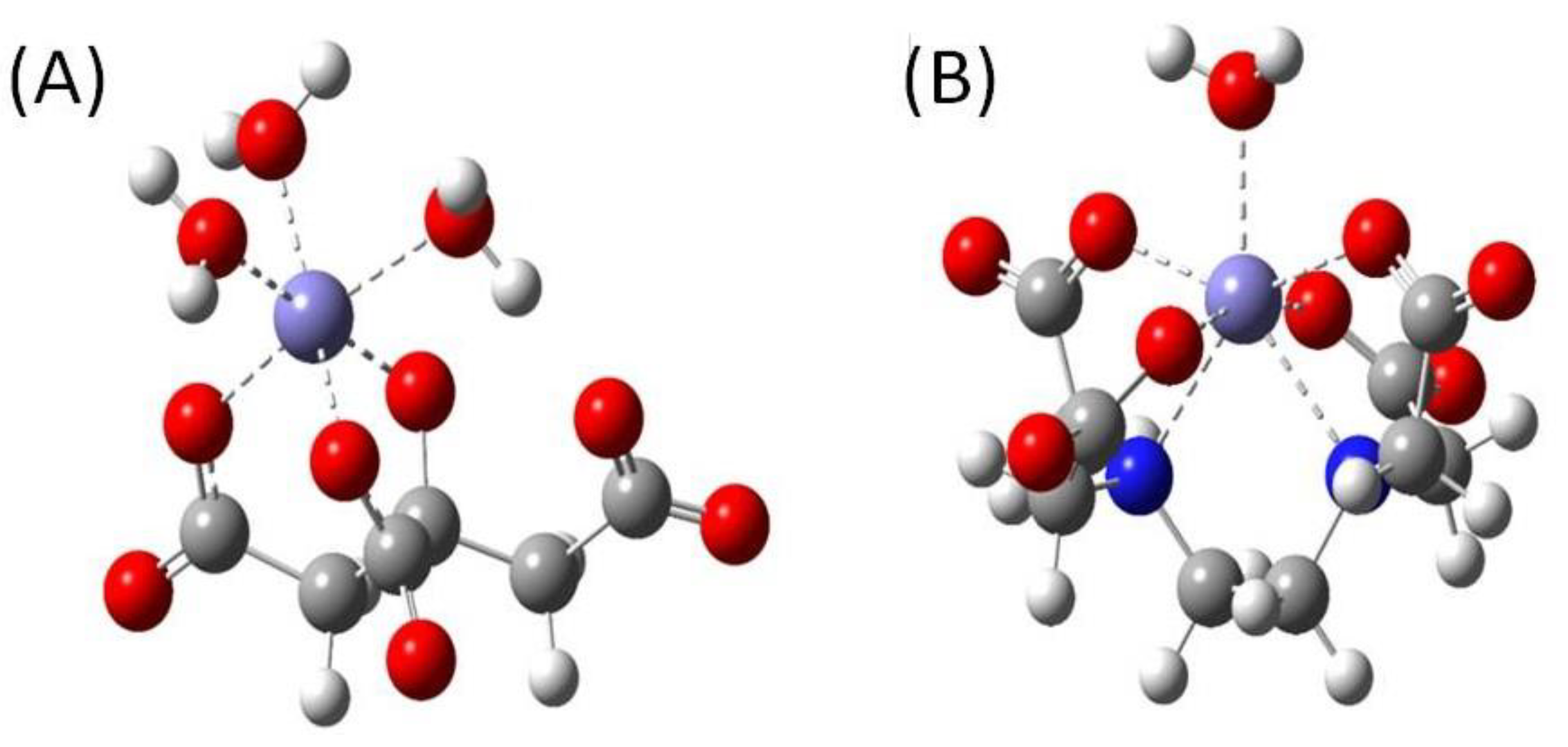
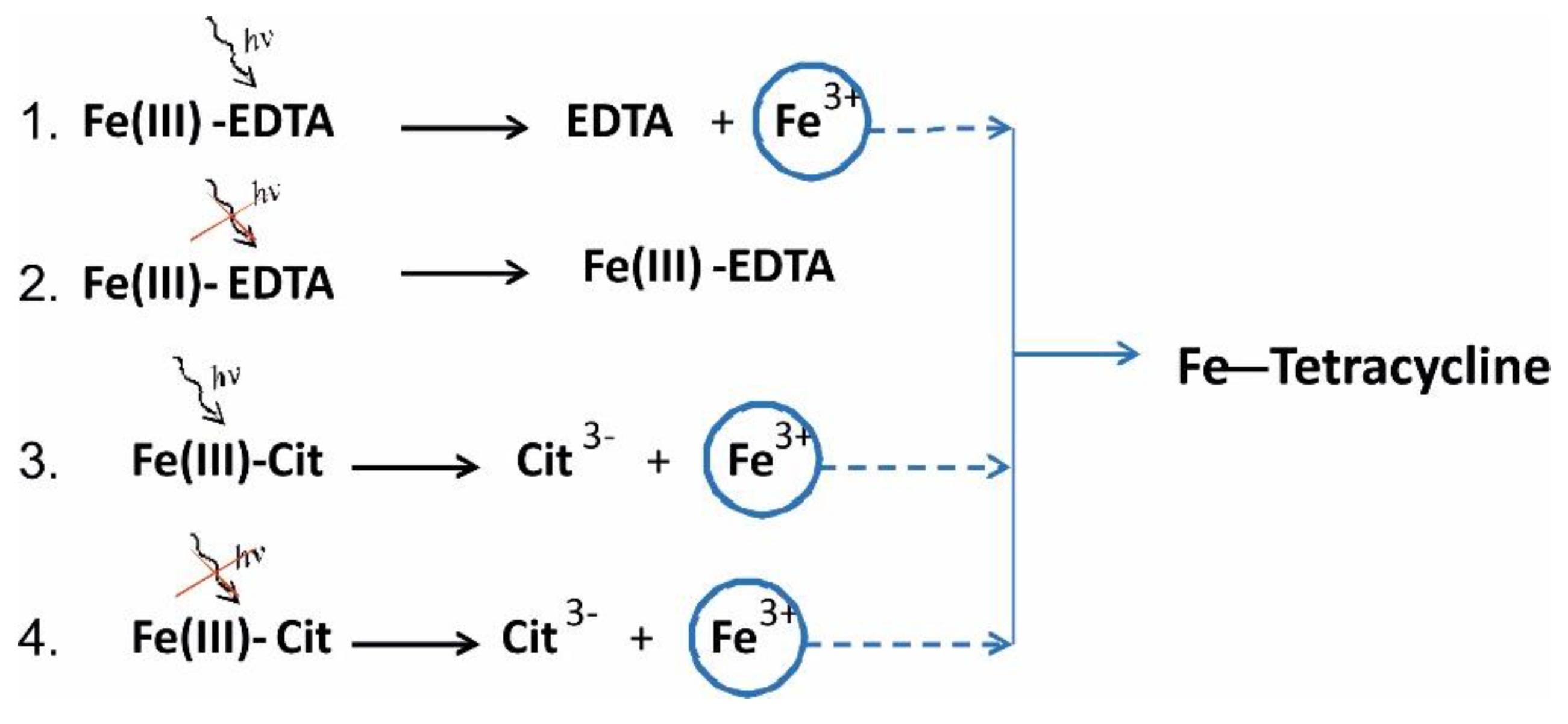
| Days | TC with Fe(III)-EDTA 20 °C | TC wtih Fe(III)-EDTA 30 °C | ||||||
|---|---|---|---|---|---|---|---|---|
| Dark | Light | Dark | Light | |||||
| C[M] ± SD × 10−5 | % | C[M] ± SD × 10−5 | % | C[M] ± SD × 10−5 | % | C[M] ± SD × 10−5 | % | |
| 0 | 5.00 ± 0.02 | 100 ± 0 | 5.00 ± 0.02 | 100 ± 0 | 4.97 ± 0.01 | 99 ± 0 | 4.97 ± 0.01 | 99 ± 1 |
| 1 | 4.95 ± 0.05 | 99 ± 1 | 4.86 ±0.10 | 97 ± 2 | 4.89 ± 0.05 | 98 ± 1 | 4.70 ± 0.10 | 90 ± 2 |
| 2 | 4.92 ± 0.10 | 98±2 | 4.67 ± 0.10 | 94 ± 2 | 4.83 ± 0.10 | 97 ± 2 | 4.20 ± 0.19 | 84 ± 4 |
| 3 | 4.92 ± 0.10 | 98±2 | 4.48 ± 0.15 | 90 ± 3 | 4.79 ± 0.10 | 96 ± 2 | 3.83 ± 0.15 | 77 ± 3 |
| 5 | 4.89 ± 0.05 | 98 ± 1 | 4.00 ±0.15 | 80 ± 3 | 4.66 ± 0.05 | 94 ± 1 | 2.19 ± 0.25 | 44 ± 5 |
| 7 | 4.86 ± 0.05 | 97 ± 2 | * | * | 4.57 ± 0.10 | 92 ± 2 | * | * |
| 9 | 4.85 ± 0.05 | 97 ± 3 | * | * | 4.52 ± 0.15 | 91 ± 3 | * | * |
| Days | TC with Fe(III)-Cit 20 °C | TC with Fe(III)-Cit 30 °C | ||||||
|---|---|---|---|---|---|---|---|---|
| Dark | Light | Dark | Light | |||||
| C[M] ± SD × 10−5 | % | C[M] ± SD × 10−5 | % | C[M] ± SD × 10−5 | % | C[M] ± SD × 10−5 | % | |
| 0 | 4.26 ± 0.01 | 85 ± 2 | 4.26 ± 0.01 | 85 ± 3 | 4.17 ± 0.02 | 83 ± 1 | 4.17 ± 0.02 | 83 ± 1 |
| 1 | 3.86 ± 0.13 | 77 ± 3 | 3.19 ± 0.17 | 64 ± 4 | 2.94 ± 0.13 | 59 ± 3 | 1.47 ± 0.08 | 29 ± 2 |
| 2 | 3.43 ± 0.08 | 69 ± 2 | 2.36 ± 0.08 | 47 ± 2 | 2.09 ± 0.08 | 42 ± 2 | 0.82 ± 0.24 | 16 ± 4 |
| 3 | 2.96 ± 0.17 | 59 ± 4 | 1.47 ± 0.04 | 29 ± 1 | 1.71 ± 0.04 | 34 ± 1 | 0.71 ± 0.12 | 14 ± 3 |
| 5 | 2.32 ± 0.21 | 45 ± 3 | 1.03 ± 0.05 | 21 ± 2 | 1.25 ± 0.04 | 25 ± 1 | * | * |
| 7 | 1.86 ± 0.17 | 37 ± 4 | * | * | * | * | * | * |
| 9 | 1.69 ± 0.13 | 34 ± 3 | * | * | * | * | * | * |
| Rate Constant | ||||
|---|---|---|---|---|
| Dark | Light | |||
| 20 °C | 30 °C | 20 °C | 30 °C | |
| Fe(III)-EDTA | ||||
| k [M−1day−1] | 55.4 ± 6.8 | 227 ± 12 | 1012 ± 93 | 2050 ± 210 |
| R2 | 0.9296 | 0.9862 | 0.9751 | 0.9787 |
| Fe(III)-Cit | ||||
| k [M−1day−1] | 4240 ± 180 | 11,330 ± 290 | 15,440 ± 1450 | 40,270 ± 5180 |
| R2 | 0.9913 | 0.9980 | 0.9744 | 0.9679 |
| Molecule | Number of Conformers Obtained from GMMX | Number of Conformers Successfully Optimized with QM Method | Number of Important Low-Energy Conformations (Population > 1%) | Energies of Low-Energy Conformations (Hartree) | Free Energy of the Ensemble (Hartree) |
| Cit | 5 | 4 | 4 | −758.350139 | −758.350832 |
| −758.349923 | |||||
| −758.348538 | |||||
| −758.348006 | |||||
| EDTA | 132 | 100 (−4 duplicates) | 15 | −1100.360670 | −1100.361119 |
| −1100.360201 | |||||
| −1100.358954 | |||||
| −1100.358872 | |||||
| Fe(III) | 1 | 1 | 1 | −123.298870 | −123.298870 |
| H2O | 1 | 1 | 1 | −76.462870 | −76.462870 |
| Cit+Fe(III) + 3H2O | 1 | 1 | 1 | −1111.363139 | −1111.363139 |
| EDTA+Fe(III) + H2O | 1 | 1 | 1 | −1300.459440 | −1300.459440 |
| Molecule | Number of Conformers Obtained from GMMX | Number of Conformers Successfully Optimized with QM Method | Number of Important Low-Energy Conformations (Population > 1%) | Energies of Low-Energy Conformations (Hartree) | Free Energy of the Ensemble (Hartree) |
|---|---|---|---|---|---|
| Cit | 5 | 4 | 4 | −757.917685 | −757.918345 |
| −757.917232 | |||||
| −757.916617 | |||||
| −757.915169 | |||||
| EDTA | 132 | 83 (−1 duplicate) | 19 | −1099.719945 | −1099.720685 |
| −1099.718671 | |||||
| −1099.717932 | |||||
| −1099.717467 | |||||
| Fe(III) | 1 | 1 | 1 | −123.298870 | −123.298870 |
| H2O | 1 | 1 | 1 | −76.418013 | −76.418013 |
| Cit + Fe(III) + 3H2O | 1 | 1 | 1 | −1110.680331 | −1110.680331 |
| EDTA + Fe(III) + H2O | 1 | 1 | 1 | −1299.659800 | −1299.659800 |
Publisher’s Note: MDPI stays neutral with regard to jurisdictional claims in published maps and institutional affiliations. |
© 2022 by the authors. Licensee MDPI, Basel, Switzerland. This article is an open access article distributed under the terms and conditions of the Creative Commons Attribution (CC BY) license (https://creativecommons.org/licenses/by/4.0/).
Share and Cite
Piotrowicz-Cieślak, A.I.; Maciejczyk, M.; Margas, M.; Rydzyński, D.; Grajek, H.; Michalczyk, D.J.; Wasilewski, J.; Smyk, B. Studies on the Efficiency of Iron Release from Fe(III)-EDTA and Fe(III)-Cit and the Suitability of These Compounds for Tetracycline Degradation. Molecules 2022, 27, 8498. https://doi.org/10.3390/molecules27238498
Piotrowicz-Cieślak AI, Maciejczyk M, Margas M, Rydzyński D, Grajek H, Michalczyk DJ, Wasilewski J, Smyk B. Studies on the Efficiency of Iron Release from Fe(III)-EDTA and Fe(III)-Cit and the Suitability of These Compounds for Tetracycline Degradation. Molecules. 2022; 27(23):8498. https://doi.org/10.3390/molecules27238498
Chicago/Turabian StylePiotrowicz-Cieślak, Agnieszka I., Maciej Maciejczyk, Małgorzata Margas, Dariusz Rydzyński, Hanna Grajek, Dariusz J. Michalczyk, Janusz Wasilewski, and Bogdan Smyk. 2022. "Studies on the Efficiency of Iron Release from Fe(III)-EDTA and Fe(III)-Cit and the Suitability of These Compounds for Tetracycline Degradation" Molecules 27, no. 23: 8498. https://doi.org/10.3390/molecules27238498





